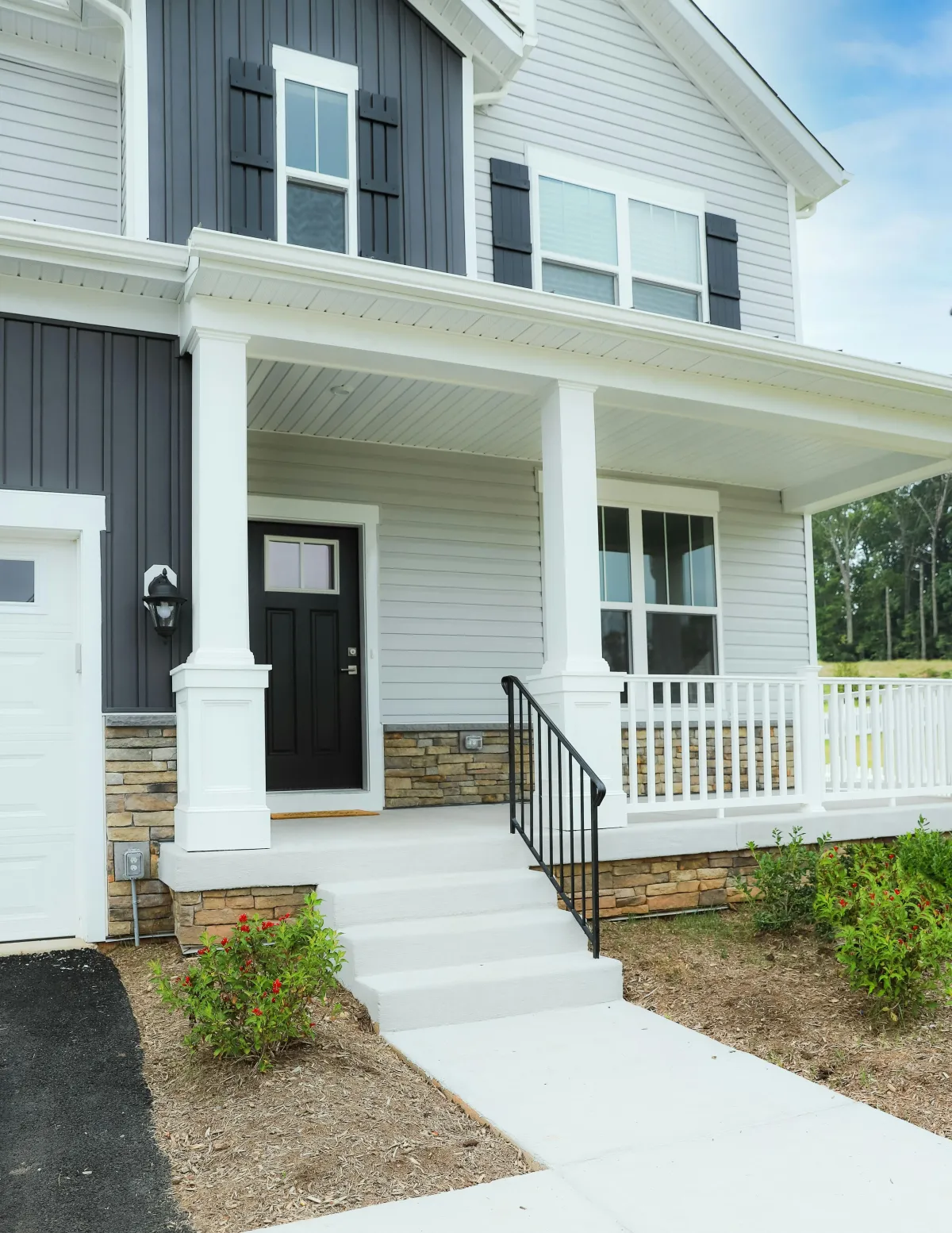
Sustainable Materials Transforming Modern Home Construction
Sustainable home construction is rapidly changing the way homeowners design and build custom homes. By incorporating green building materials, today’s projects prioritize energy efficiency, durability, and environmental responsibility. These materials reduce waste, improve indoor air quality, and help lower long-term utility costs. From insulation and cladding to flooring and windows, eco-friendly choices support both modern performance and future-focused living. This guide explores how green materials are reshaping residential construction and what homeowners should consider when selecting them.
Key Takeaways
Green building materials boost energy efficiency, reduce environmental impact, and improve indoor air quality.
Sustainable insulation, cladding, and flooring offer long-term energy savings and durability.
Energy-efficient windows, doors, and low-VOC paints create healthier and more comfortable indoor environments.
Professional installation and expert design consultation optimize material performance.
Market trends and innovative materials are driving a revolution in sustainable construction.
What Are Green Building Materials and Why Are They Essential for Modern Homes?

Green building materials are essential in modern custom home construction for their ability to minimize environmental impact and enhance energy performance. They support healthier indoor environments and lower utility costs through improved thermal efficiency. Using renewable, recycled, and low-emission components, these materials foster long-term sustainability. Their adoption plays a central role in building durable, efficient, and future-ready homes.
How Does Sustainable Insulation Impact Home Energy Savings and Comfort?
Sustainable insulation minimizes thermal transfer, reducing reliance on HVAC systems and lowering energy bills. It stabilizes indoor temperature, making living spaces more comfortable year-round. High-performance options reduce drafts and hot spots, promoting even airflow. These materials can improve sound insulation between rooms. Consistent thermal performance extends the life of heating and cooling equipment. Proper insulation decreases carbon emissions by optimizing energy use. It also contributes to a quieter, healthier environment. Collectively, these benefits make insulation a top priority in green construction.
What Are the Installation Best Practices for Eco-Friendly Insulation?
Installers should seal gaps and voids to prevent air leaks and thermal bridging. Vapor barriers should be used where necessary to control moisture flow. Material thickness and placement must follow local energy codes for optimal performance. Blown-in insulation should be evenly distributed without compressing fibers. Batts must fit snugly around framing without leaving gaps. Professional installation ensures long-term durability and comfort. Proper tools and safety gear are essential due to dust or loose fibers. Following manufacturer guidelines guarantees energy efficiency and indoor quality.
How Do Costs Compare Among Different Sustainable Insulation Materials?
Upfront costs vary by material, with some natural insulations priced higher due to production methods. However, long-term energy savings often outweigh initial investments. Homeowners should compare life cycle costs rather than just retail prices. Recycled or locally sourced materials may offer lower transportation fees. Government incentives can help offset costs for approved green upgrades. Maintenance and replacement needs are also reduced with durable products. Proper installation maximizes return on investment. When calculated over time, many green insulations prove highly cost-effective.
How Are Eco-Friendly Cladding Materials Transforming Home Exteriors?

Eco-friendly cladding materials are redefining exterior design by offering a blend of performance, sustainability, and visual appeal. These materials reduce reliance on resource-intensive options and add thermal insulation to building envelopes. Their durability helps reduce maintenance needs and supports long-term value. With weather resistance and design flexibility, they adapt to various architectural styles. Their use reflects a growing focus on eco-conscious construction in modern homebuilding.
What Are the Benefits of Reclaimed Wood, Bamboo, and Composite Siding?
Reclaimed wood reduces waste by repurposing previously used timber, adding character and history to exteriors. Bamboo is a rapidly renewable material known for strength and moisture resistance. Composite siding combines recycled content and binding agents to form a long-lasting, low-maintenance solution. These materials reduce dependence on raw resources while providing durability. All three can improve insulation and thermal performance. Their versatility supports both contemporary and rustic home designs. They require less frequent refinishing or replacement. Their environmental and aesthetic value supports sustainable goals.
How Do Eco-Friendly Cladding Options Enhance Durability and Aesthetics?
Green cladding materials resist moisture, pests, and weather-related damage, supporting longevity. Their coatings and finishes maintain color and texture with minimal upkeep. These materials allow for customizable colors, grains, and surface patterns. Design flexibility enables seamless blending with both traditional and modern architecture. Sustainable choices often have longer lifespans than conventional products. Thermal properties support indoor comfort and efficiency. The blend of beauty and strength makes them ideal for custom builds. Their visual appeal complements exterior design while reinforcing environmental responsibility.
What Should Homeowners Consider When Choosing Sustainable Cladding?
Homeowners should evaluate moisture resistance, material lifespan, and thermal properties. Compatibility with the home’s structural system and climate zone is essential. Installation complexity and long-term upkeep requirements also influence choice. Access to skilled labor and local availability may affect feasibility. Budget planning should include both initial cost and maintenance. Environmental certifications or ratings help verify product quality. Aesthetic preferences should align with neighborhood style or homeowner vision. Balancing performance with design ensures the best outcome.
What Sustainable Flooring Materials Are Best for Green Home Construction?

Sustainable flooring supports green home goals by offering low-emission materials that reduce environmental impact. These flooring options are made from renewable or reclaimed resources, enhancing indoor comfort and air quality. They are also durable, cost-effective over time, and visually appealing. Their natural insulation properties help regulate temperature and sound. By selecting eco-friendly flooring, homeowners promote long-term sustainability and wellness.
How Do Bamboo, Cork, and Reclaimed Wood Flooring Compare in Sustainability and Durability?
Bamboo grows rapidly, making it highly renewable and suitable for areas with moderate foot traffic. Cork is harvested without harming trees and offers excellent sound absorption and softness. Reclaimed wood reduces waste and adds rustic appeal with a unique finish. All three options minimize environmental impact during sourcing. Their durability depends on finishing, maintenance, and room use. These materials perform well under eco-conscious construction standards. Their sustainable sourcing enhances their appeal in custom home design. Each supports longevity with proper care.
What Are the Installation and Maintenance Tips for Sustainable Flooring?
Before installation, flooring should acclimate to indoor humidity and temperature. Subfloors must be level and clean for proper adhesion. Moisture barriers are recommended for cork and reclaimed wood. Use low-VOC adhesives or finishes to maintain air quality. Cleaning should involve eco-friendly, non-abrasive products. Regular sweeping and damp mopping preserve finish and appearance. Recoating or refinishing as needed extends the material’s life. Following manufacturer guidelines ensures maximum durability and comfort.
How Does Sustainable Flooring Contribute to Indoor Air Quality and Comfort?
Eco-friendly flooring releases fewer pollutants, supporting healthier indoor environments. Low-emission adhesives and finishes prevent the buildup of harmful chemicals. Natural insulation properties help maintain consistent indoor temperatures. Materials like cork and reclaimed wood reduce noise between rooms. Comfortable underfoot textures enhance the livability of each space. Cleanable surfaces prevent dust and allergen accumulation. These benefits support respiratory health and well-being. Sustainable flooring plays a key role in home comfort and air quality.
How Do Energy-Efficient Windows and Doors Enhance Green Building Performance?

Energy-efficient windows and doors reduce air leakage and heat transfer, playing a major role in improving home performance. They help stabilize indoor temperatures and reduce HVAC usage, which cuts energy costs. These components enhance both comfort and sustainability. Advanced materials and glazing techniques block unwanted heat while letting in natural light. Their performance supports long-term energy goals in green custom builds.
What Are the Features of Windows and Doors Made From Recycled Materials?
Windows and doors made from recycled aluminum or engineered materials are designed for high durability and thermal resistance. These frames often include insulation breaks to reduce heat loss. Multi-pane glass with low-emissivity coatings improves energy efficiency. Many products feature tight weather seals to minimize drafts. These options lower reliance on new resources and promote circular design. Recycled-content materials often meet green certification criteria. Their strength and low maintenance add value to long-term performance. Choosing them supports environmental and energy goals alike.
How Do Energy-Efficient Openings Reduce Home Energy Consumption?
Well-sealed windows and doors prevent conditioned air from escaping and block outdoor heat or cold. Insulated frames and multi-pane glass reduce the need for heating and cooling. Tight-fitting designs with compression seals reduce air infiltration. These systems work with insulation to maintain consistent indoor climates. Lower HVAC loads mean decreased utility costs and less energy waste. Consistency in interior temperatures enhances comfort across seasons. These improvements support sustainability at every stage. Energy-efficient openings are essential in green home planning.
What Are the Design and Installation Considerations for Sustainable Windows and Doors?
Windows and doors should be placed strategically to maximize daylight and reduce heat gain. Orientation, overhangs, and room usage affect performance outcomes. Installation must include proper flashing, insulation, and sealing to prevent moisture or air leaks. Compatibility with wall assemblies improves structural integrity. Climate-specific glazing ensures performance in hot or variable environments. Professional fitting helps prevent thermal bridging and ensures airtight finishes. Hardware choices also impact security and energy performance. Careful planning optimizes both aesthetics and efficiency.
How Can Homeowners Choose the Right Green Building Materials for Their Construction Projects?

Choosing the right materials for sustainable construction requires balancing performance, environmental impact, and cost. Homeowners should evaluate how products contribute to energy efficiency, indoor air quality, and long-term durability. Assessing climate suitability and life cycle performance is key. Making informed choices supports both comfort and sustainability in custom home builds.
What Factors Should Influence Material Selection in Sustainable Home Building?
Material selection should consider thermal performance, renewability, and local climate compatibility. Lifespan and maintenance needs also affect long-term value. Cost efficiency, especially through energy savings, plays a major role. Evaluate ease of installation and compatibility with structural systems. Look for third-party certifications to verify sustainability claims. Local sourcing helps reduce transportation emissions and supports the regional economy. Design flexibility and finish options should align with the home’s aesthetic. A well-rounded evaluation ensures materials support both function and sustainability.
How Do Cost, Durability, and Environmental Impact Compare Across Green Materials?
Some green materials cost more upfront due to production or sourcing methods. However, their durability often reduces long-term replacement or repair costs. Materials made from recycled or renewable sources usually carry a smaller carbon footprint. Low-maintenance options save on upkeep and resources over time. Comparisons for home building materials should factor in lifespan, energy efficiency, and health benefits. Proper installation helps maximize material value. Smart selection based on use case and location leads to stronger outcomes. Overall, cost must be weighed against long-term environmental and financial returns.
What Role Do Professional Installation and Design Consultation Play in Material Performance?
Proper installation ensures green materials function as designed and meet energy goals. Professional oversight minimizes errors like poor sealing, moisture issues, or thermal bridging. Design consultation helps align materials with architectural plans and performance standards. Experts assess material compatibility and identify high-impact upgrades. Proper sequencing of trades avoids delays or damage during construction. Installers ensure that certifications and warranties remain valid. Design input supports both aesthetics and technical outcomes. Working with experienced teams maximizes value from every sustainable feature.
Frequently Asked Questions
What defines green building materials?
Green building materials are environmentally responsible products designed to reduce energy consumption, improve air quality, and support sustainable construction. They are often made from recycled, renewable, or low-toxin resources, offering durability and lower long-term environmental impact.
How do green materials help in reducing energy consumption?
These materials offer high thermal resistance, which reduces the need for excessive heating or cooling. By stabilizing indoor temperatures, they decrease reliance on HVAC systems, leading to lower energy bills and a more comfortable home year-round.
Are low-VOC paints beneficial for indoor air quality?
Yes, low-VOC paints release fewer harmful chemicals into the air, significantly improving indoor air quality. They reduce the risk of allergies, respiratory irritation, and long-term health issues, making them ideal for family living spaces.
What are the cost implications of switching to green building materials?
While some eco-friendly options may have a higher initial price, they typically offer long-term savings through energy efficiency and reduced maintenance. Their durability, combined with performance benefits, often results in a better overall return on investment.
Can green building materials help in achieving certification like LEED?
Absolutely. Many green materials contribute toward meeting certification standards such as LEED and ENERGY STAR. While Custom Builder Connection does not directly manage certification, they can connect homeowners with experienced builders and designers who understand sustainability goals and help incorporate eco-friendly features into the overall home design.
Conclusion
Green building materials are revolutionizing modern home construction by merging environmental sustainability with high-performance design. They enhance energy efficiency, improve indoor air quality, and reduce environmental impact, setting new standards for custom construction. Homeowners are encouraged to select eco-friendly insulation, cladding, flooring, windows, and low-VOC paints, and to seek professional guidance to optimize performance and achieve long-term savings.


